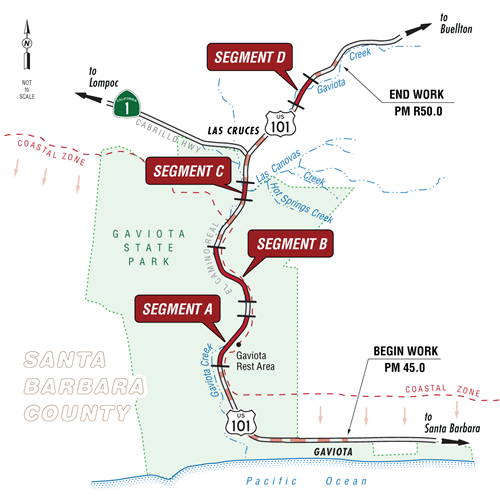Gaviota Creek Improvement Project
Project Description
The project is divided into two components:
Tier 1 (Program-level analysis)— The project proposes to restore historical fish access at several locations along Gaviota Creek and U.S. 101 in Santa Barbara County. The project will address deficiencies of several existing grade control structures and culverts that present barriers to fish passage. Barriers would be removed and replaced with a roughened channel. Additional retaining structures or modifications to existing structures will be built to strengthen and stabilize the creek bank and highway shoulders. Foundation work could be required at some locations to strengthen the existing concrete retaining system.
Tier 2 (Project-level analysis)— Segment A constitutes the initial Tier 2 project.
Segment A: Five grade control structures are located along Gaviota Creek on the west side of U.S. 101 from post miles 46.9 to 47.2, near the northbound Gaviota Rest Area and the entrance to the Gaviota Tunnel. The California Fish Passage Advisory Committee has identified the grade control structures located within Segment A as priority locations within Caltrans District 5 for improvement to accommodate fish passage. The Caltrans 2019 Fish Passage Annual Legislative Report estimates that approximately 28.37 cumulative miles of Steelhead habitat is found upstream of these barriers. The weirs would be removed and replaced with a roughened channel with jump heights not to exceed 6 inches. Additional retaining structures or modifications to existing structures will be constructed to stabilize the creek bank and highway shoulders.
- Grade Control Structure 1 post mile 46.92
- Grade Control Structure 2 post mile 46.95
- Grade Control Structure 3 post mile 47.12
- Grade Control Structure 4 post mile 47.15
- Grade Control Structure 5 post mile 47.19
A tiered approach is being used to reduce time and to improve efficiency by eliminating repetitive analyses of issues that were addressed in the Tier 1 program level evaluation. All components of the project will be analyzed under one document and implemented in phases as funding becomes available.

Project Benefits
Purpose
The purpose of this project is to address fish passage barriers in Gaviota Creek, improve and restore drainage conditions in and adjacent to Gaviota Creek, and stabilize the structures supporting the US 101 highway shoulder and embankment.
Need
This project is needed because scour has undermined several existing grade control structures, culverts, sack-concrete bank protection, and retaining walls in Gaviota Creek. A culvert system at post mile 49.6 has several deficiencies with the potential to undermine its structure, including substantial scour at the culvert’s outlet. These conditions create barriers for the endangered southern California steelhead population and threatens the stability of US 101 if left unaddressed.
Documents
Accessibility Assistance: Caltrans makes every attempt to ensure our documents are accessible. Due to variances between assistive technologies, there may be portions of this document which are not accessible. Where documents cannot be made accessible, we are committed to providing alternative access to the content. Should you need additional assistance, please contact us at (916) 654-2852 or visit https://dot.ca.gov/request-ada-compliant-documents.
Comments were collected during the scoping period for the Draft Programmatic Environmental Impact Report from October 18, 2022 to December 16, 2022. The public scoping comment period has now closed.
Virtual Public Meeting
A virtual public scoping meeting was held on Tuesday, November 1, 2022. To view the presentation, please visit: https://www.youtube.com/watch?v=YAz2O2xRzrA
Project Contact
Hallie Holden, Project Manager
Phone: (916) 995-1421
Email: hallie.holden@dot.ca.gov
Dianna Beck, Senior Environmental Planner
Phone: (805) 459-9406
Email:dianna.beck@dot.ca.gov
Public Information Office, Caltrans District 5
Phone: (805) 549-3318
Email: info-d5@dot.ca.gov
Title VI Information
The California Department of Transportation (Caltrans) assures that no person shall, on the basis of race, color, or national origin, be excluded from participation in, be denied the benefits of, or be otherwise subjected to discrimination under any program or activity receiving Federal financial assistance, as required by Title VI of the Civil Rights Act of 1964, as amended, the Civil Rights Restoration Act of 1987, and Federal Executive Order 12898 (Federal Actions to Address Environmental Justice in Minority Populations and Low-Income Populations).
Caltrans will make every effort to ensure nondiscrimination in all of its programs and activities, whether they are federally funded or not, and that services and benefits are fairly distributed to all people, regardless of race, color, or national origin. In addition, Caltrans will facilitate meaningful participation in the transportation planning process in a nondiscriminatory manner.
- Title VI Brochure (English, PDF)
- Title VI Brochure (Spanish, PDF)
- Title VI of the Civil Rights Act of 1964 (Caltrans Information)

